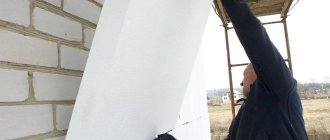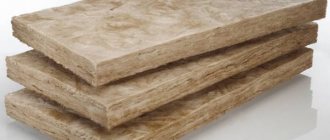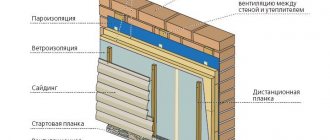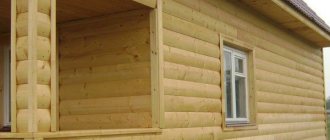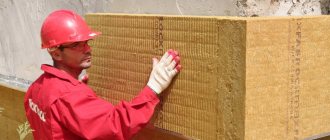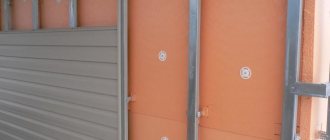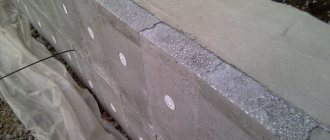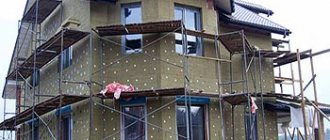The installation of an insulating layer using mineralized wool is an alternative solution to insulation with polystyrene foam. Mineral wool has certain advantages and has some features during installation work. Let's figure out what the technology of insulating a facade with mineral wool under plaster is.
Why mineral wool
Previously, this material was considered very toxic and was used extremely rarely in private construction. But modern production no longer uses harmful resins, which released toxic substances even with slight heating. Now mineral wool is considered an environmentally friendly material with excellent technical characteristics.
| Stove brand | Index | |||||
| Application area | Density, kg/m3 | Thermal conductivity, W/m*K | Compressive strength, kPa | Water absorption,% | Content of organic substances, % by weight | |
| PM-40 | Soft PM slab, for unloaded heat and sound insulation of pitched roofs, ceilings, floors, frame partitions | 40…45 | 0.042 | — | 30 | 3 |
| PM-50 | >45… | 0.042 | — | 30 | 3 | |
| 55 | ||||||
| PP-60 | Semi-rigid PP slab, for unloaded heat and sound insulation of pitched roofs, ceilings, floors, frame structures, three-layer walls made of brick and aerated concrete | >55… | 0.04 | 4 | 25 | 3.5 |
| 65 | ||||||
| PP-70 | >65… | 0.039 | 8 | 20 | 3.5 | |
| 75 | ||||||
| PP-80 | >75… | 0.039 | 20 | 15 | 4 | |
| 90 | ||||||
| PZh100 | Rigid slab PZh, for heat and sound insulation of walls, incl. ventilated facades, basement floors on the lower side, three-layer walls made of brick and aerated concrete | >90… | 0.038 | 25 | 15 | 4 |
| 110 | ||||||
| PZh-120 | >110…130 | 0.039 | 30 | 15 | 4.5 | |
| PZh-140 | >130…150 | 0.039 | 35 | 15 | 4.5 | |
| PPZh-160 | A plate of increased rigidity, for heat and sound insulation of loaded roofs made of corrugated sheets and reinforced concrete. slabs without screed | >150…170 | 0.042 | 40 | 12 | 5 |
| PPZh-180 | >170…190 | 0.044 | 50 | 12 | 5 | |
| PPZh-200 | >190…210 | 0.045 | 60 | 12 | 5 | |
| PT-220 | Solid PT slab, for heat and sound insulation of loaded roofs made of corrugated sheets and reinforced concrete. slabs, finishing slabs for ceilings, noise insulation, sound insulation of floors, partitions | >210…230 | 0.045 | 80 | 10 | 7 |
| PT-250 | >230…270 | 0.045 | 100 | 8 | 7.5 | |
| PT-300 | >270…330 | 0.046 | 150 | 6 | 10 |
There are several types of insulation:
- Glass wool is an excellent option for insulating walls outside. It allows steam to escape from interior spaces, but at the same time retains heat in them. quite durable and elastic material. But there is a small drawback - during installation you must use safety glasses and a respirator. Small particles can enter the eyes and respiratory tract, causing irritation.
- Slag is the most inexpensive representative of this category of insulation. Absorbs a lot of water and has relatively high thermal conductivity. Therefore, it is rarely used for external insulation, and then a layer is taken 2 times thicker than necessary.
- Rock wool is an excellent choice for insulation. There are no such problems with this material as with glass wool, and the technical characteristics allow you to insulate the house from the outside without hesitation. It allows steam to pass through, insulates noise and heat loss, does not absorb moisture at all and does not burn.
- Basalt is also a suitable option for façade insulation. It has the same characteristics as stone wool, but is made from a different main component.
This insulation is more popular than polystyrene foam because it can allow steam to pass through, which means it does not require additional ventilation. But mineral wool will cost a little more, although it’s hardly worth sparing money for your own comfort.
Advantages of insulating facades with foam plastic and mineral wool
Minvata | Styrofoam |
| Ideal for insulating facades of wooden houses. Here, mineral wool even surpasses foam plastic in its characteristics, according to experts, since it allows air to pass through better. A wooden structure will retain wear resistance precisely when insulated with mineral wool, which supports air exchange. | The material has high thermal insulation characteristics. It is ideal for insulating facades, as well as loggias with balconies, foundations and attics. It is widely used in modern construction, despite the production of more modern materials. |
| Mineral wool can withstand extremely high temperatures. This is relevant when insulating the facades of bathhouse complexes. | Craftsmen are more willing to work with foam plastic. It has a transparent installation algorithm, allowing work to be carried out in a short time, with the highest quality possible. |
| When, when installing an insulating layer, excellent noise insulation levels are expected to be achieved, the best option is to use mineral wool. It surpasses polystyrene foam in terms of sound insulation parameters. | As an insulation material, polystyrene foam is attractive due to its high wear resistance. It withstands sudden temperature changes and negative environmental influences, while maintaining its original technical parameters. Thanks to this, a layer of plaster, correctly applied to the insulating foam surface, will look flawless even after several seasons of use in difficult climatic conditions. |
| Mineral wool does not have such a high density as polystyrene foam. It is capable of transmitting moisture, ensuring its evaporation, and has convection properties. In this regard, many specialists, builders and ordinary consumers - home owners consider mineral wool to be more environmentally friendly than polystyrene foam. | Master builders note that when insulating the walls of bath complexes, saunas and buildings made of natural wood, foam plastic is inferior in terms of environmental friendliness to mineral wool. Polystyrene foam is not capable of providing convection, it does not allow the insulated surface to “breathe”, and does not support good air exchange. |
We provided a table, examined the advantages of both materials as an insulating layer for a facade, and made some comparisons.
Important! One conclusion can be drawn: when providing insulation for the walls of buildings made of natural wood, mineral wool is of greater interest. Due to its ability to maintain air exchange and moisture evaporation, it is ahead of foam. At the same time, it is with polystyrene foam that you can install insulation efficiently, as quickly as possible, with minimal time costs.
Table - technical characteristics of mineral wool
Roll sizes
Slab sizes
In general, it can be noted that both materials have good performance, are modern insulation materials, popular and in demand in the construction market.
Polyfoam sheet
Polystyrene foam size chart
Main stages of installation
Mineral wool under plaster must be installed according to all the rules, since heavy material will be applied for decoration. In addition, the mineral wool must be securely fixed so that it does not deform during operation and does not spoil the decorative finish. Therefore, you should adhere to the following plan:
- Preparing the base.
- Fixing mineral wool.
- Thermal insulation reinforcement.
- Plastering.
Now you need to figure out what to do at each stage, find out if there are any nuances.
Required materials and tools
Before starting the insulation process with this material, you need to prepare the following materials:
- wool slabs;
- galvanized starting profiles, on which the first row of thermal insulation layer is applied;
- “mushroom” dowels made of plastic – they have a plastic core and a wide head;
- fiberglass reinforcing mesh, which will be resistant to alkalis from cement mortar;
- cement-based facade plaster, also a decorative composition for plastering;
- foam for sealing seams between adjacent slabs;
- primer with antiseptic.
After preparing the materials, you need to prepare the necessary tools:
- Hammer and drills to make holes in mineral wool.
- Spatulas of different sizes, with and without teeth, for distributing the mounting solution.
- Level, tape measure, plumb line and other devices for measuring and monitoring the correct installation of insulation.
- Rollers, brushes for priming.
Base
Insulating a house with mineral wool begins with preparing the foundation. New buildings do not require spending a large amount of time and money at this stage. It is enough to treat the outside walls of the house with deep penetration soil, which will protect the base from moisture and also increase adhesion.
Structures with a longer service life require more thorough preparation:
- Removing the old decorative layer. Using mineral wool under plaster will be impossible if there are traces of paint or decorative plaster on the surface.
- Cleaning walls from dirt, dust, traces of biological organisms, old fasteners and hanging parts.
- Filling potholes and mounting holes. In some cases, when the walls have strong differences exceeding 1 cm, it is necessary to do rough plastering. This will help level the surface.
- Application of primer.
Only after the base is completely dry can you proceed to the next stage.
Cost per square meter of work
Installation specialists can offer professional execution of wet finishing of the building facade. Labor costs are calculated as follows:
- Preparing the base of the walls;
- Installation of slabs;
- Application of a reinforcing layer;
- Formation of plaster texture;
- Finishing window slopes;
- Installation and dismantling of scaffolding, etc.
For example, Stroy-Continent has a cost of 1 sq. m of facade insulation starts at 350 rubles, and the group’s price for installing slabs is slightly higher - from 390 rubles per 1 sq. m. m. "LuxElitStroy" for such work puts forward a price of 380 rubles, and the "Brigade of Private Craftsmen" set a price of 300 rubles per square.
Note! It must be taken into account that the cost of facade insulation does not include the remaining stages of work.
High-quality work will provide housing with savings on heating costs, and will also protect it from climate “surprises” for many decades. After all, with proper installation of insulation, the service life of the building increases by 30 years.
Fixing the insulation
Before covering the facade of the house with mineral wool under plaster, you should install a starting profile. It performs the following functions:
- Protection of insulation from moisture and rodents.
- Support for the thermal insulation structure, which will protect against deformation.
- Preservation of the gap between the wall and the bottom row of mineral wool.
The profile can be metal, plastic or wood. Wood is used extremely rarely, since it quickly becomes unusable, although it is inexpensive. You need to fix the starting bar at a height of 40–60 cm from the ground, using dowels.
Now you can begin installing the insulation. This is done in 2 stages:
Stage 1
Gluing. Select an adhesive composition that is suitable for outdoor use and a certain type of mineral wool. In the case of dry mixtures, the solution should be prepared independently. Begin installing thermal insulation from the lower left corner.
Apply the finished mixture in a thin layer to one side of the mineral wool, and then make 5 large blots (4 in the corners and 1 in the center). Next, the slab is applied to the base and held for some time for adhesion.
The next element is placed close to the previous one. When starting to lay the second row, you need to take into account that the joints of the mineral wool should not coincide. Therefore, you should adhere to the principle of brickwork with bandaged seams.
Stage 2
Fixation with dowels. This fastening is done only after the adhesive solution has completely dried. Usually this is about 24 hours, but manufacturers indicate a more precise time on the glue packaging. To fix one slab you need to use up to 8 dowels. It all depends on the size.
One fastener is installed at the corners of the insulation, closer to the joints, and several in the center. To make such fasteners, you need to make a hole using a hammer drill, which will be 1.5–2 cm longer than the length of the dowel. Next, insert the anchor and screw or drive in the core (it all depends on the structure of the dowel).
Rating of the best stone wool manufacturers
There are eight successful mineral wool manufacturers that produce high-quality products at an affordable price:
- ROCKWOOL. A Danish company that occupies a leading position in the production of thermal insulation materials. The ROCKWOOL company has been manufacturing mineral wool since 1909. During this time, she managed to establish herself as a manufacturer of quality products.
- Knauf. This German company produces mineral wool and other building materials. It produces mineral wool, which is suitable for creating acoustic partitions, as well as insulating walls and facades.
- Isover. The company specializes in the production of thermal insulation materials. The stone wool produced by the manufacturer Isover is of very high quality. It is very strong and resistant to high humidity and temperature changes.
- Paroc. This Finnish company produces basalt wool for facade insulation. Paroc mineral wool is resistant to atmospheric changes and high temperatures.
- Ursa. A relatively young German-Spanish company producing insulation materials. At first the company was engaged in the production of fiberglass boards. However, now she specializes in creating high-quality mineral wool.
- IZOVOL. The company produces insulation for floors, walls and roofs. The mineral wool produced by IZOVOL is dense, non-flammable and resistant to moisture.
- Beltep. This Belarusian manufacturer specializes in creating mineral wool from basalt. The manufactured products are very durable and tough.
- TechnoNIKOL. The company produces thermal insulation materials for insulating facades. The mineral wool of this company is processed with special means, thanks to which it is possible to improve its thermal insulation properties.
Mineral wool reinforcement
After the entire surface is covered with thermal insulation and securely fixed, you need to prepare the facade for plaster. To do this, use a reinforcing fiberglass mesh with small cells and hydrophobic glue.
The corners are reinforced first. The glue is applied in a thin layer to the mineral wool. The size of the treated area should be 15–20 cm larger per piece of mesh. Then the reinforcing fabric is applied so that there is material of the same size on both sides of the corner.
Using a wide spatula, the mesh is pressed into the glue. It is strictly forbidden to apply the mesh first and then apply the glue. This reduces the effectiveness of the reinforcement. Next, they begin to apply fiberglass to the entire surface of the walls. Everything is done using the same technology as the corners. The material needs to be joined with an overlap of 10–15 cm.
Pros and cons of using mineral wool for external thermal insulation of a house
The popularity of insulation is primarily due to:
- low thermal conductivity of the material, and therefore high thermal insulation characteristics;
- excellent sound insulation;
- good level of fire safety (after all, mineral wool does not support combustion);
- vapor permeability (provides “breathing” of the house, which is especially important if the house is not wooden, but stone);
- resistance to fungi and rodents;
- relative environmental friendliness and safety of the material (harmful substances are released only when heated to more than 300 ° C);
- simplicity of installation technology.
Thermal insulation of the facade using mineral wool can be done independently
As disadvantages it is worth noting:
- change in the volume of insulation and the appearance of cracks in it (occurs only when there is no reinforcing layer);
- If mineral wool is not treated with a hydrophobic solution, all its thermal insulation characteristics will come to naught, because it almost instantly absorbs moisture.
Plastering
If, after the glue has dried, with the reinforcing mesh fixed, large irregularities are visible, then rough plastering needs to be done. It will completely hide imperfections and make the surface smooth.
In cases where there are small differences, decorative plaster is applied immediately. In this case, you need to adhere to the principle of finishing. The method of application will depend on the selected texture.
If the composition did not have a coloring component, then after drying you need to apply 2-3 layers of paint. Here you need to be careful when choosing paint; it must be combined with the composition of the plaster.
How to properly lath under mineral wool on the outside of a wall
The sequence of your actions when insulating walls should be as follows:
- All work surfaces must be thoroughly cleaned and sanitized.
- It is necessary to dismantle various strips, frames, ebbs and other elements.
- Any holes in the wall should be covered with hemp or special mastic.
- The wooden components under the siding are impregnated with a fire-resistant primer, and the walls are coated with an antiseptic.
The sheathing under the mineral wool should be made from wooden blocks (they will later be used to attach the siding). The distance between the beams depends on the width of the slabs being laid.
The sheathing is secured with galvanized nails or dowels. The bars can be placed both horizontally and vertically.
It is necessary to additionally fix the cladding around the perimeter of window and door openings . At the same time, do not forget to check the plane of the frame by level.
The thickness of the wooden beam must correspond to the insulation layer.
NOTE!
The insulating material must fit tightly into its sections . It is best to lay mineral wool slabs in a checkerboard pattern, while covering the joints.
Now let's look at step-by-step instructions for insulating the walls of a private house.
Installation of sheathing
How to choose the right plaster composition?
Silicone putty for facade finishing
In order to plaster mineral wool, you can use different mixtures. It is important that the raw material fits well and does not create difficulties during the work process.
To obtain a durable layer 3 mm thick, the following types of solution are used:
- Silicone plaster. The mixture is sold in finished form. Plastering this mineral wool insulation has many advantages. It is not susceptible to mechanical damage, is waterproof and does not fade in direct sunlight. The surface finished with this method allows steam to pass through well and is also capable of self-cleaning during the rainy season.
- Composition based on white cement. Sold dry. The solution has good vapor permeability, which is very important for mineral wool. It should also be noted the durability and low cost of the composition.
- Polysilicon (silicate). This plaster is perfect for finishing mineral wool. Sold ready-made.
The acrylic mixture is used less often. This is due to poor vapor permeability. In addition to its disadvantages, such plaster has a number of advantages. It is highly resistant to mechanical damage and cannot fade in the sun.
In order to save money, owners often resort to applying cement mixtures to mineral wool. Since such compositions have a gray tint, they are subsequently required to be painted in the desired color.
What is a wet façade?
Insulation of facades with wet plaster is complex work on external insulation of walls and their finishing, which is carried out with wet solutions, such as adhesives and plaster. The coating consists of the following main layers:
- Glue. Thanks to it, thermal insulation boards are fixed and the walls of the building are leveled.
- Thermal insulation is the main insulating layer.
- A reinforcing layer for which a plaster-adhesive base and fiberglass reinforcing mesh are used. This allows you to increase the strength characteristics of the structure.
- Decorative finishing. It is used to protect walls from external influences and shape the architectural appearance of the house.
Plastering facades for the purpose of insulation involves the additional use of the following elements:
- Primer - used to treat the main wall, reinforcing layer and decorative plaster before painting it.
- Disc-shaped dowels - allow you to attach insulation to the wall.
- Perforated corner profile - used to form and strengthen corners.
- Perforated base profile - installed on the lower load-bearing element of the covering structure.
Advantages of wet facades
Using the wet finishing method allows you to create architectural styles that will be in fashion for at least another 20 years. Such houses have an expensive and substantial appearance, despite the fact that their cost is the lowest. The use of basalt wool and plaster has many advantages, among which are:
- significant reduction in heat loss of the building due to reduced thermal conductivity of the entire structure;
- a huge number of existing architectural solutions;
- safety of internal space;
- insulation and plastering of facades not only during construction work, but also if the buildings are already in operation;
- reducing costs for heating and air conditioning of buildings;
- good soundproofing properties of the finish;
- creating a favorable indoor microclimate;
- increasing the service life of the building;
- no load on the building structure;
- low cost;
- ease of installation;
- ease of material replacement and repair.
Disadvantages of wet facades
The disadvantages of this method include the seasonality factor of installation work. According to the technology, laying a wet facade is carried out from late spring to early autumn. If you do not comply with all conditions and standards, then such work will significantly reduce the service life of the facade, causing cracks to form on it.
- Temperature values for work should be from +5 to +30°C.
- It is forbidden to work during rainfall or if there is high humidity in the air, since drying of the adhesive and plaster layers will be difficult.
- For high-quality finishing, it is necessary to protect the facade from exposure to the sun and winds.
Plastering technology of the selected insulation
The plastering process begins after waiting for the reinforced layer to completely dry. As in the case of preparing walls for plaster, the surface is primed in two passes. The plaster layer is applied with a trowel or spatula, following the technique used to create a decorative coating with the selected effect, for example, for bark beetles, “rolling” filler grains is done.
If you plan to paint the house, then the plaster is leveled and smoothed, or puttied.
You can insulate a house not only by using warm plaster, but also by installing a “wet facade”. Having become familiar with the types of insulation suitable for this scheme, having correctly chosen the desired material, also pay attention to all the work involved in the complex, in its own way, process of insulation. Only in this case will the heat of your hearth be effectively conserved, and the walls will be protected.
